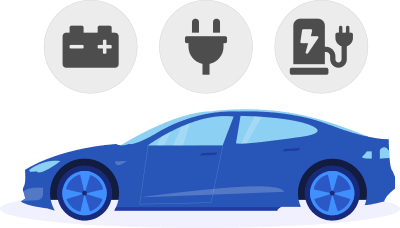
EV Route Planner - Routing and Charging Solutions for Electric Cars
Electric cars are here to stay. Electric charging ports are becoming a more common sight, and did you know there are already over 10 million electric cars on the world's roads?
What does this mean for businesses? Clearly businesses will need to embrace electric cars and electric auto navigation. Will this change how businesses calculate routes for their drivers? What will they need to consider?
Geoapify Routing API is here to help your business adjust to route planning for EVs. We can help make the switchover from fuel to EVs smoother.
People still tend to think of electric cars as prohibitively expensive, but they're becoming more affordable all the time. In the near future, electric vehicles could become roughly equivalent in price to their fuel counterparts. As they become more affordable, they'll likely grow in popularity.
Here's the truth: Most of us will be driving electric vehicles eventually. Governments around the world are making plans to replace fuel engines with electric ones. Twenty four countries have agreed to end the fossil fuel era “by 2040 or sooner.”
Let's take a closer look at Route Planning for EVs and how it differs from fuel car Route Planning.
How Is Electric Vehicle Routing Different From Regular Car Routing?
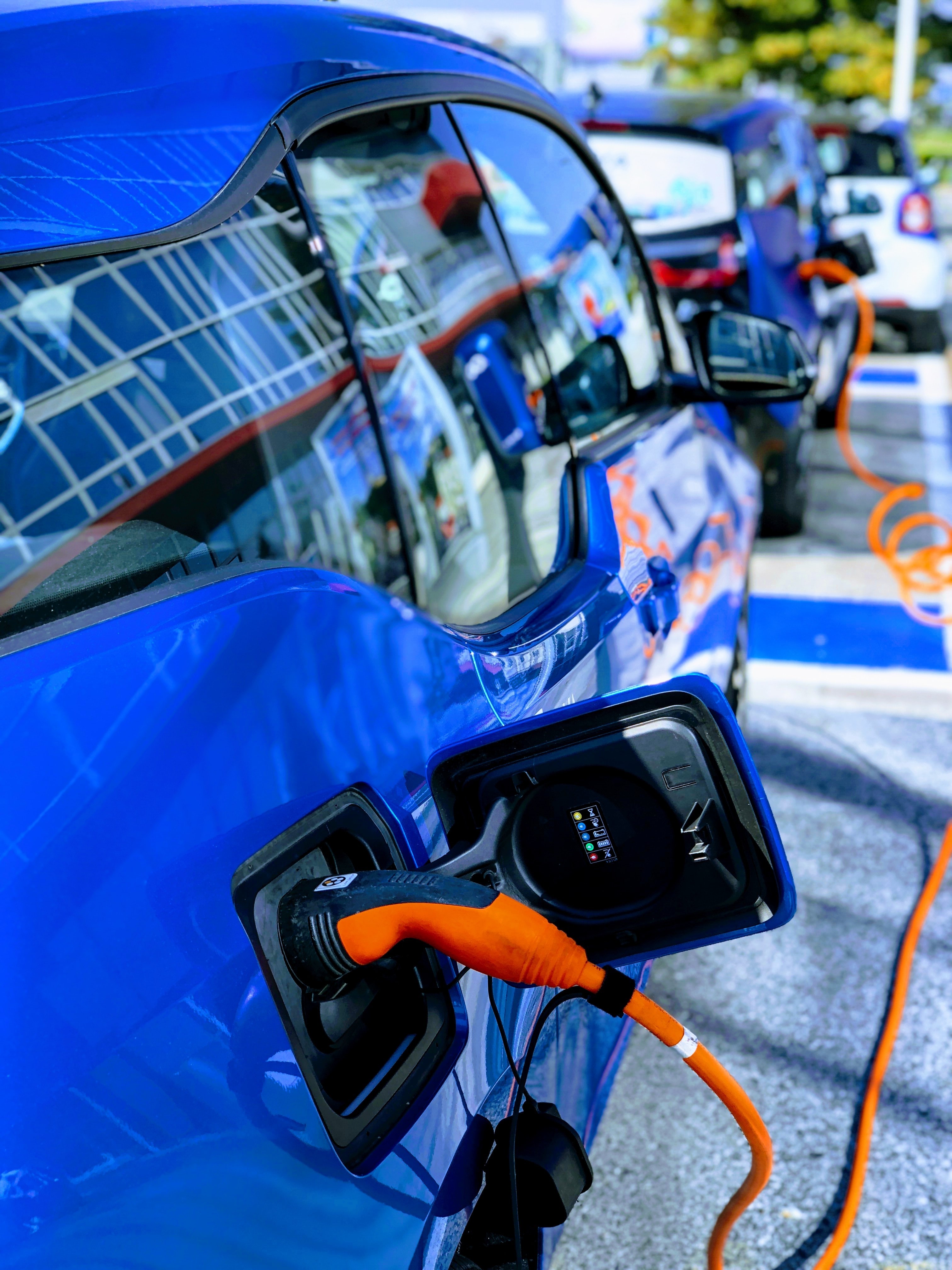
We're used to stopping at a gas station to fill up our cars. There are gas stations everywhere, so it's no trouble to pull over, top up, and drive on.
But it's not so quick and easy to recharge an EV. How far the car can get on one charge is a major concern for people who are considering switching. And charging stations aren't as numerous as gas stations yet.
This is an even bigger concern for businesses. If your business relies on a fleet of drivers to:
- Deliver food
- Carry out on-site repairs such as IT or plumbing
- Provide a service like home care or cleaning
- Deliver packages in a timely manner
You don't want your drivers held up for hours waiting for a vehicle to charge. Or running out of charge mid-journey.
Businesses that don't have a fleet of drivers still need reliable electric auto navigation. If you have salesmen who travel regularly, staff who move between different offices, or managers who carry out regular inspections or training you'll need an EV trip planner.
Even using the fast Tesla Superchargers, an EV needs 20 minutes to charge to 50%, 40 minutes to charge to 80%, and 75 minutes to reach 100%. If your drivers aren't near a Tesla station, they could be looking at an even longer wait. Depending on the car and the charger, it could take several hours.
For everyday journeys like commutes or errands, this isn't a big problem. Most EVs can handle normal daily trips, so drivers won't notice much difference.
But a business whose drivers travel longer distances needs an electric vehicle route planner that takes into account:
- Driving range per charge
- Charge time
- Location of charging stations
Features and Capabilities
Support for Electric Vehicles
Our APIs can be used for Electric Vehicle (EV) routing, considering factors like charging station availability and energy consumption. By combining the Routing API, Places API, Route Planner API, and Matrix API, you can create custom EV routes tailored to your specific requirements. These APIs allow you to calculate efficient routes, find charging stations, plan multi-stop trips, and optimize travel time based on charging needs.
| Feature | Description | API Used |
|---|---|---|
| Route Optimization | Calculate the most efficient route while considering battery level, charging speed, and available charging stations. | Routing API |
| Charging Station Integration | Use real-time charging station data to plan charging stops along the route. | Places API |
| Energy Consumption Models | Estimate energy usage based on factors like vehicle type, weight, and terrain. | Routing API |
| Battery Constraints | Set battery parameters, such as minimum and maximum charge levels, to optimize routing. | Route Planner API |
| Multiple Charging Strategies | Plan charging stops based on different strategies, such as quick charging or full charge options. | Matrix API & Route Planner API |
Avoid Battery Drain with Smart Routing
The EV Routing API minimizes unnecessary energy consumption by avoiding routes with steep climbs, congested traffic, or long detours. It ensures you can reach your destination without range anxiety by intelligently selecting charging stops along the way.
Charging Station Filters
The Places API provides a category for charging stations and returns details such as connector type, charging speed, and operator. This information helps you identify suitable charging locations based on your vehicle’s requirements.
Example of URL quering charging stations:
https://api.geoapify.com/v2/places?categories=service.vehicle.charging_station&filter=rect:-78.48381596993971,39.21387171305534,-77.90687948419568,38.771099254152034&limit=20&apiKey=YOUR_API_KEYAvoid Unwanted Route Parts
Avoid routes that don’t suit your EV or preferences, such as ferries, highways, or specific countries. The API provides flexibility in tailoring your journey to avoid unnecessary obstacles or undesirable routes.
Get Directions and Instructions
The EV Routing API provides detailed turn-by-turn navigation instructions in multiple languages, including English, German, French, and more. Directions include stops for charging stations and estimated arrival times based on energy consumption.
See Elevation Profiles
Elevation profiles are included for EV routes, allowing you to gauge the impact of terrain on your energy consumption. For example, routes with significant elevation changes may suggest additional charging stops to ensure you reach your destination.
Easy to Integrate
The EV Routing API is accessible through HTTP GET requests, making it easy to integrate into your application regardless of the programming language you use. Results are returned as GeoJSON objects, enabling seamless interaction with mapping tools.
Based on Open Data
Geoapify's EV Routing API is built on open data, allowing you to store, analyze, and redistribute results with proper attributions. This makes it ideal for developers building open or proprietary solutions.
What Should You Consider When Using an EV Route Planner?
Here are four things to consider when planning an EV route.
1. The distance the car can travel on one charge
The first consideration is how far the car can go on a single charge. This isn't a simple one size fits all calculation. Factors that affect range include:
- Road class
- Speed limits
- Route elevation
- Whether the driver uses electric features such as heating or air conditioning
All of these affect energy consumption and can reduce the distance a car can go on a single charge.
2. Battery charging time
Keep in mind that the time it takes to charge the battery can vary, too. Consider:
- The battery size (bigger batteries typically take longer)
- How much charge the battery already has
- The ambient temperature (cooler temperatures can slow down charging)
- The maximum charging rate of both the EV and the charging station. No matter how fast the EV battery rate, if the charging station has a slower maximum rate, that will limit charging speed
Charging stations differ by both type of charger and speed. A 7kw fast charger can add up to 30 miles of range per hour of charging, but a 3KW slow charger will only add up to fifteen. The bigger the battery and the slower the charging point, the longer it will take to get your EV from empty to full
3. Whether you can combine charging stops with other activities
When you know how long it's going to take to charge your EV, you can factor that time into your route. And if you can combine charging stops with periods when your driver wouldn't be on the road anyway, that's going to save even more time.
Try combining charging stops with lunchtime, appointments, training sessions, or longer client visits (such as a hefty repair job or a complex IT installation.) You can also use overnight charging to cut down how much your drivers need to charge when out and about.
4. Whether you can use top up charging
You don't have to charge from empty to full every time. For example, you can charge the battery from 65% to full and boost available driving time, without the need for a full charging session.
This method is ideal for situations where the driver will be stopped for a while, such as a manager attending a conference, or a sales trainer carrying out a session. They can plug in the car, and it will be ready when they're done.
Top up charging isn't so helpful for drivers who make a series of shorter stops, like delivery drivers.
What Does Ideal Electric Vehicle Routing Look Like?
The newness and unfamiliarity makes it seem like EV routing is a whole different task than standard routing.
You might be wondering if EVs need a completely different route planner than fuel cars. The thought of learning and implementing a whole new routing software is daunting.
Thankfully, the answer is no, you don't need a different route planner.
EV routing does have some specific differences, but these are related to the actual infrastructure of EV driving, such as the number of charging points and locations. This underdevelopment of infrastructure can raise some challenges when route planning.
EV and fuel route planning are the same at heart
So, there are differences in infrastructure, but the planning itself is the same for EVs as it is for fuel cars. The experience of driving doesn't change. Your drivers need to know:
- Where they're going.
- How they're going to get there.
- Any restrictions such as height or toll bridges.
- And where they can top up their car, whether that's with fuel or electricity.
You don't need to provide detailed instructions such as “stop here and charge your battery for 12 minutes until it reaches 67% full.” All this does is cause drivers more stress, by creating a rigid plan.
Energy consumption differs between drivers, so don't try to plan every stop and charge. If you were planning for a fuel car, you'd allow for driving conditions, elevation, and driving speed. So, when planning an EV route, you need to allow for factors that affect energy consumption, such as elevation, speed, and use of other electrical features.
Provide your drivers with all the information they need about the route, including where to find charging stations. That way, they can keep an eye on their battery consumption and decide when and where to stop and charge up.
The ideal EV route planner is the same as the ideal fuel vehicle route planner - "Simple and Useful".
How Does EV Routing Compare With Fuel Car Routing?
Let's take a closer look at how EV route planner compares with fuel car routing:

1. One battery charge distance = One fuel fill distance
The simplest approach is to treat one battery charge distance the way you'd treat one fuel fill distance. It's not new or complicated. It's simply showing your drivers:
- Where along the route they'll need to start searching for a charging station.
- Where their vehicle will stop if they don't charge it up.
You could use colored lines to help them visualize. A green one for full and ok to keep driving, yellow for needs to charge soon, and red for the vehicle will stop here.
You don't need to provide exact distances to the last mile. Estimate the distance available before needing to charge, so your drivers have an idea in mind. Then they can compare that with their actual progress on the day, and make an informed decision.
If you can estimate fuel consumption changes based on route elevation and vehicle speed, you can do the same for battery consumption.
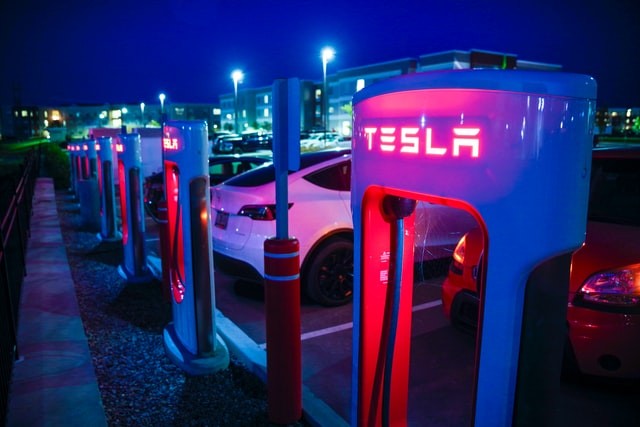
2. Charging station = Gas station
You'd show gas station locations for drivers in fuel cars. For EVs, show charging station locations. You can make this even more informative for your drivers by adding:
- The number of available plugs
- Type or speed of charging port
- Nearby amenities such as cafes, restaurants, WC, or playgrounds
- Proximity to the places they need to stop to carry out their work
Let drivers filter results based on these parameters so they can choose the best station for their needs.

3. Other parameters to consider
Drivers still need to take breaks to visit the restroom and eat lunch, no matter what kind of vehicle they're driving. The ideal EV routing will take into account:
- Lunch and restroom breaks
- Driving conditions
- Time of day
- How much driving time is left after taking stops into consideration
The Future of EV Infrastructure
As the number of EVs on the road grows, more and more businesses and individuals will use them.
As EVs get more popular, infrastructure will also improve. In the future, it will be as normal to stop to charge your car, as it is to stop for gas now. We'll break open our EV road trip planners the way we used to use our fuel car road trip planners.
Today, drivers think about where they'll need to fuel up. In the future, drivers will look first for where they can charge their car. Then, they'll want to know where they can eat, shop and recreate near the charging point. Right now, people stop to fuel up and grab a snack. Before long, we could all be stopping to charge up and grab a snack.
When businesses realize the power of this, we think the number of charging points will increase explosively.
Having an on-site charging station could become a key feature that restaurants and shopping malls use to stand out from the competition. That will make it even easier to plan routes for your drivers!
But through all this, routing will stay remarkably similar, whether it's for a regular car or an electric car.
No matter the vehicle, routing should always help, not hinder. Drivers don't need binding or imperative route planning. They need helpful, convenient, and informative tools that help them make the best driving decisions.
Electric Vehicle Routing API Tutorials
Check out our tutorials to make it easy to get started and get the results you want with the Electric Vehicle Routing API:
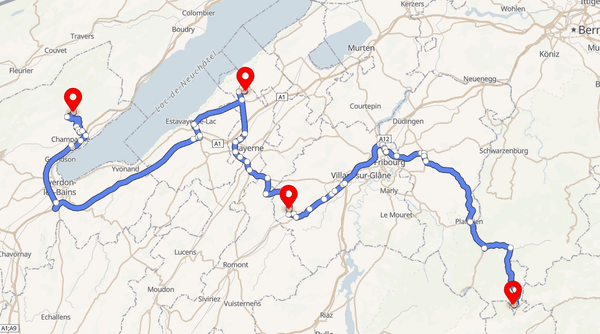
How to draw routes on a Maplibre GL (Mapbox GL) map
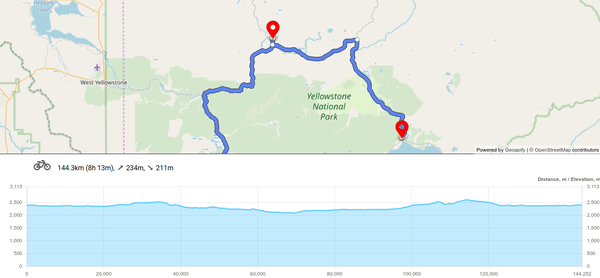
Drawing Route Elevation Profile with Chart.js
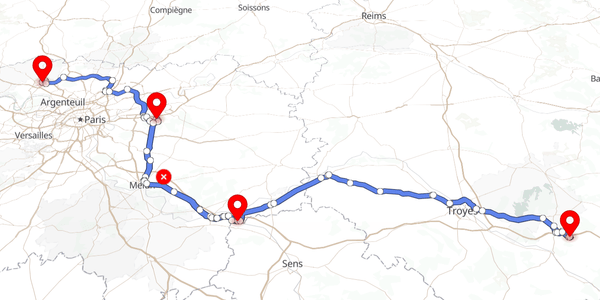
How to use the Route Directions API
Still not sure how to start? If you're facing any problems or have questions, we're here to help! Contact us and we will be happy to assist.
How Much Does It Cost?
We offer flexible pricing to suit businesses of all sizes. Our free plan includes up to 3,000 credits per day, with costs depending on usage volume and the API types used.
For example, credit consumption for Routing API:
- Each pair of waypoints costs 1 credit.
- Routes exceeding 500 kilometers incur an additional credit per 500 km.
Use our Pricing Calculator to estimate your credit needs.
Geoapify Helps You Create Straightforward EV Routing
Geoapify can help you create straightforward EV routing, whether you currently use routing APIs for your business, or you're new to them.
You can use Geoapify Route Planner to calculate EV routes and pack them with useful information for your drivers. We also add route elevation profiles to our results, which helps you estimate energy consumption.
With Geoapify Places API and Place Details API, you can find charging stations and amenities so your drivers know the best places to stop.
As your business starts using electric vehicles, you can use Geoapify Routing API to create a perfect EV navigator. Show important places and amenities, as well as charging stations and distance per charge estimates.
Need help? Get in touch and we'll help you design the ideal EV routing for your business.